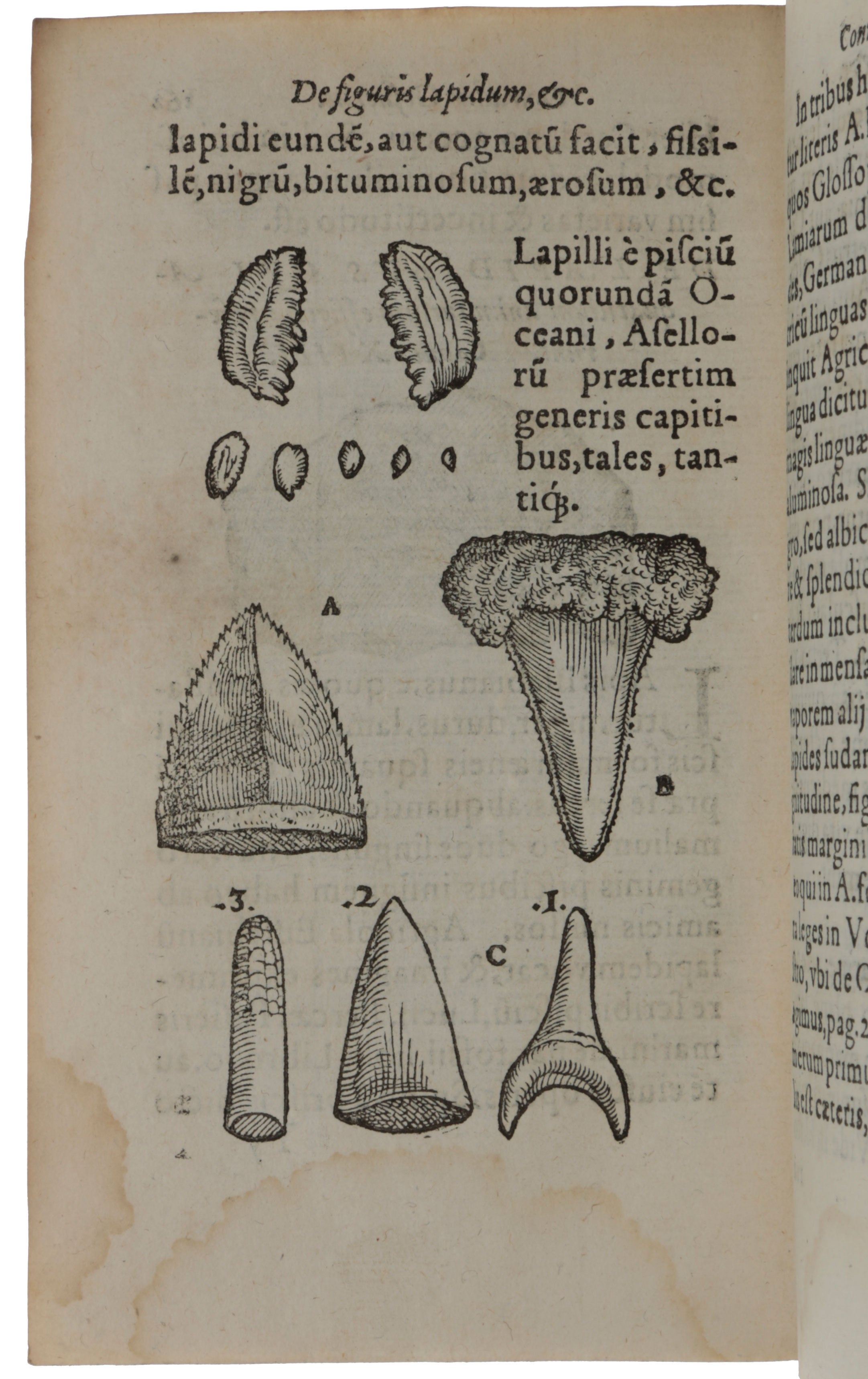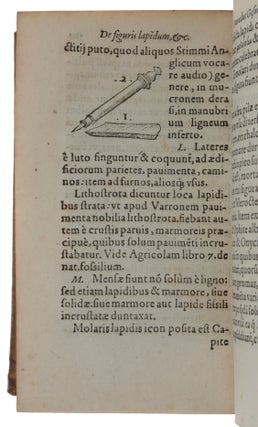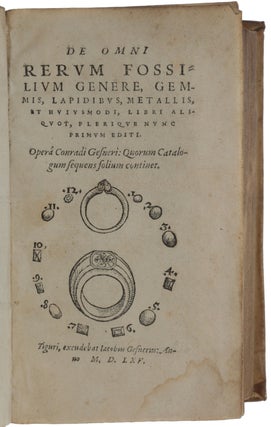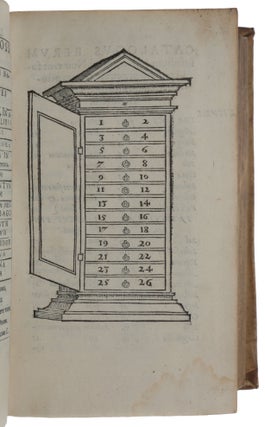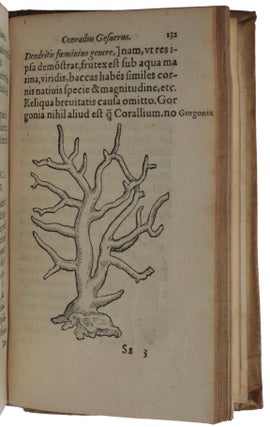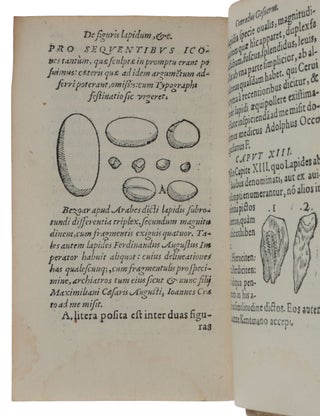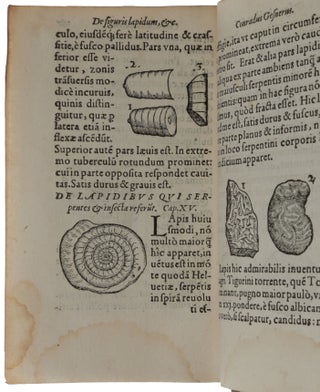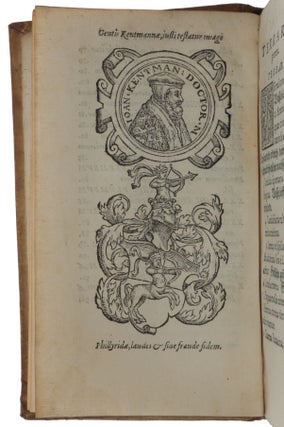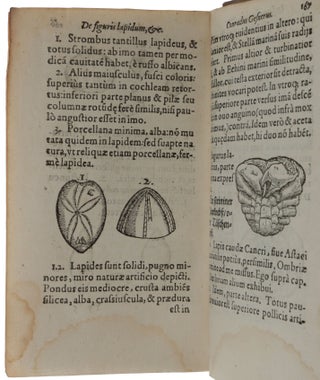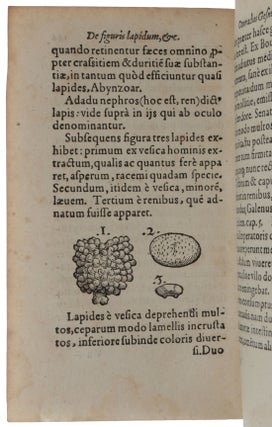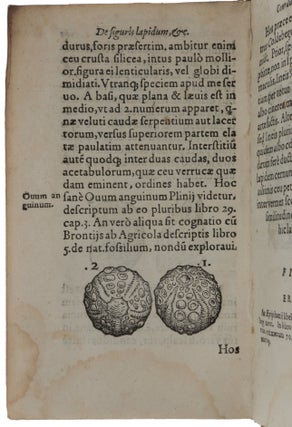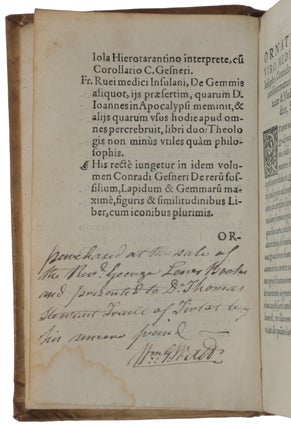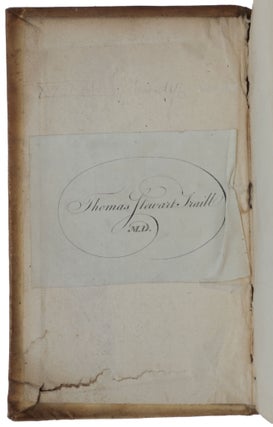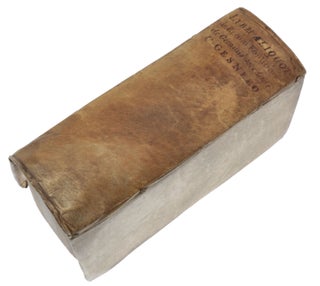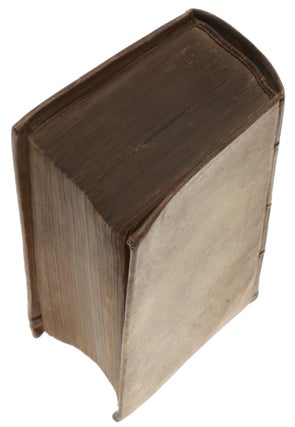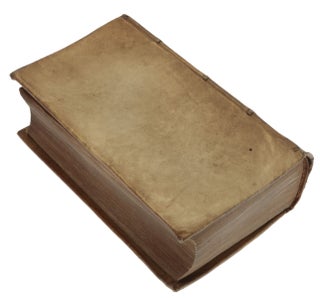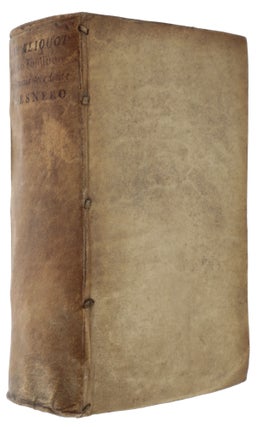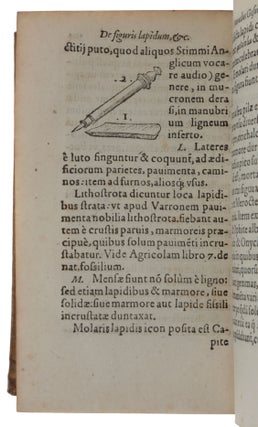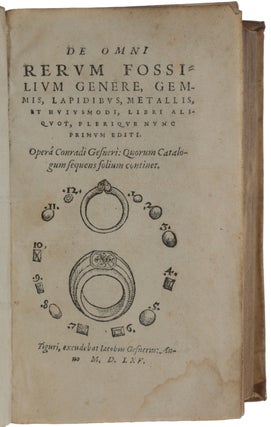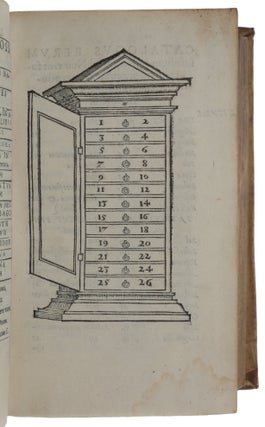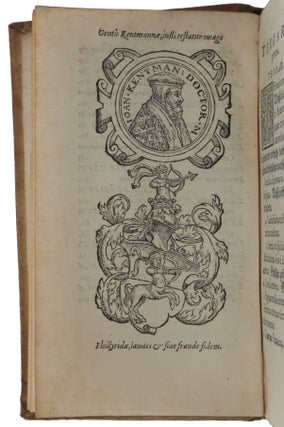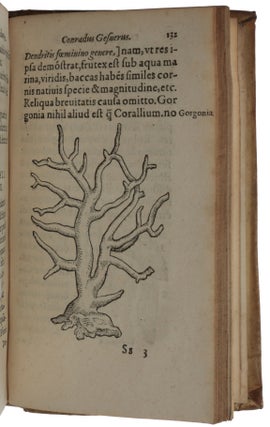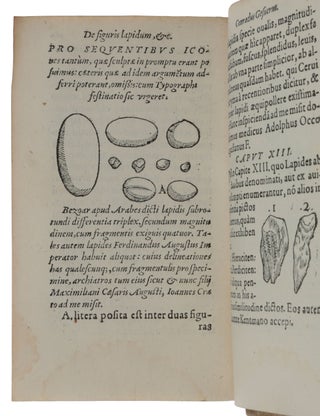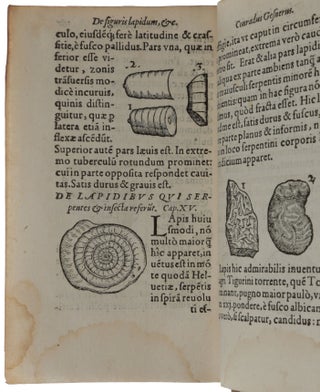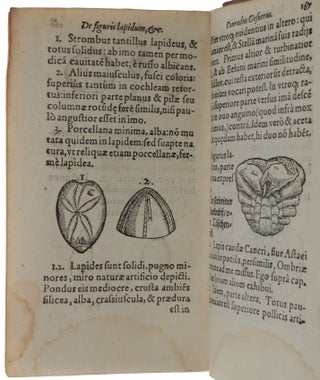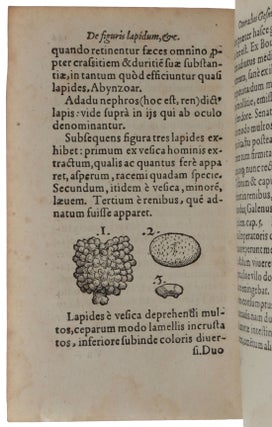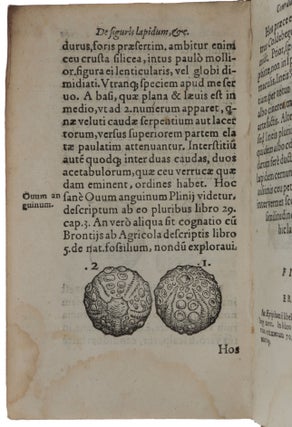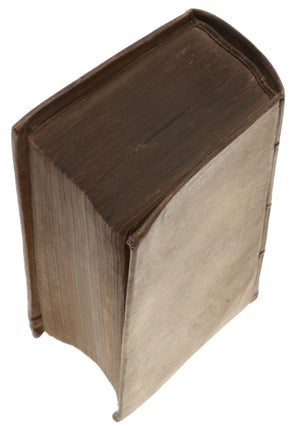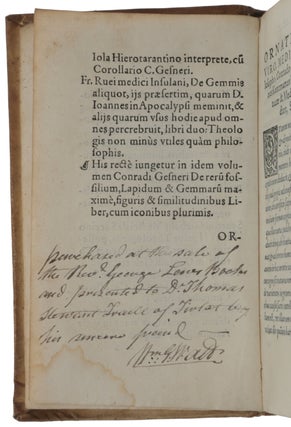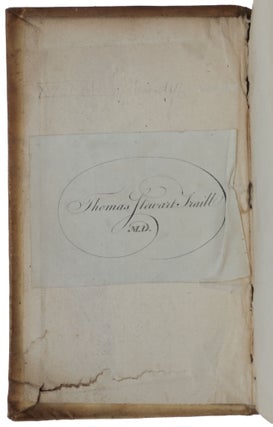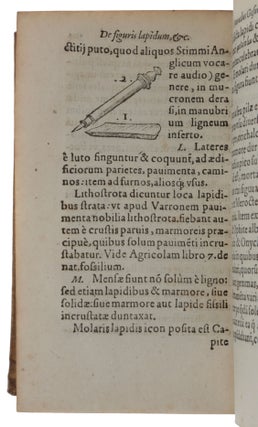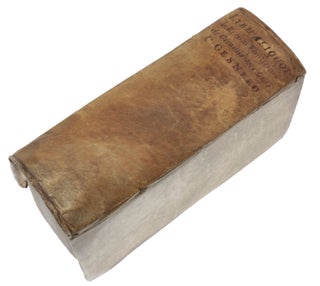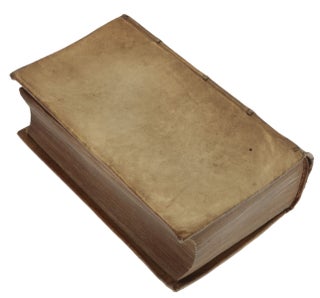De Omni Rerum Fossilium Genere, Gemmis, Lapidibus, Metallis, et huiusmodi, libri aliquot, plerique nunc primum editi. Opera Conradi Gesneri: Quorum Catalogum sequens folium cominet.
Zürich: Jacob Gesner, 1565 [–1566]. First edition and a fine copy in contemporary binding, very rare when complete, of this collection of eight treatises, the most important being De rerum fossilium [On fossil Objects], Gesner’s last work, the earliest scientific attempt to classify the mineral kingdom, and the first illustrated book on fossils. “It presents a picture of the mineral kingdom as seen through the eyes of the greatest naturalist of his time” (Adams). Gesner’s work contains numerous woodcuts after his own drawings, many of which are still preserved in Basel University Library. Gesner’s book also famously contains the first printed illustration of a lead pencil (f. 104v). The other seven other works, by six authors, in this composite volume were all edited by Gesner. They include the first appearance of a catalogue of a mineral collection, that of Johannes Kentmann, “stated to have been the first man in Europe to make a collection of minerals.” His catalogue contains entries for sixteen hundred specimens, making it a “conspectus of most of the minerals known at that time, with the localities from which they were derived as well as an exact equivalent in German of the various names by which they were known in Latin” (Adams, pp. 195-196). “On 28 July 1565 Conrad Gesner (1516-65), the greatest naturalist of his century, completed the book On fossil Objects. It is an appropriate date to choose as a starting point for [the] history of palaeontology. Gesner’s book marked a crucial moment in the emergence of the science, for it incorporated three innovations of outstanding importance for the future … Gesner’s concern for precise identification provides the context for the most important innovation … It was the first in which illustrations were used systematically to supplement a text on fossils. The importance of this can hardly be exaggerated … without illustrations no writer could be certain that he was applying a name in the same sense as his predecessors … The basis for [Gesner’s] descriptive work was the formation of a collection of specimens. Published illustrations were, in effect, merely a convenient substitute for a museum … Agricola and other early writers may well have formed collections of their own, but Gesner’s book is the first work on fossils that clearly refers to such a collection. Gesner expressed his gratitude to his friend the physician Johannes Kentmann of Torgau (1518-74) for sending him specimens to supplement his own, and he repaid the debt by placing the catalogue of Kentmann’s collection at the front of the composite volume in which his own work was bound. The importance of the museum as an innovation in this branch of natural history is symbolised by the frontispiece of Kentmann’s catalogue – the only illustration it contained. His little cabinet with its numbered drawers was termed significantly an ‘ark’ … [The third innovation is that Gesner’s] is the first such work in which there is a clear expression of a programme of co-operative research on fossils. Gesner had already received specimens and drawings from Kentmann and several other correspondents, but his book was explicitly designed to elicit further information of the same kind” (Rudwick, pp. 1-11). ABPC/RBH list only two complete copies since Honeyman: Freilich (Sotheby’s New York, January 11, 2001, lot 209, $87,000) and Macclesfield (Sotheby’s, November 4, 2004, lot 890, £26,400 = $49,122). Provenance: Thomas Stewart Traill, M.D. (1781–1862), physician, chemist, meteorologist, zoologist and specialist in medical jurisprudence, FRSE from 1819 (engraved bookplate of on front pastedown and an inscription in brown ink “Purchased at the sale of Revd. George Loves Books and presented to Dr Thomas Stewart Traill of Tirlet, by his sincere friend, Wm. G. Watt” – i.e., William Graham Watt (1776-1866), 7th Laird of Skaill House, Breckness Estate). Traill Island in Greenland and Mount Traill in Nigeria are named after him. When John James Audubon arrived in Liverpool in July 1826 Traill helped him to find a publisher for The Birds of America; in gratitude Audubon named the Traill’s flycatcher after him. “The short title of Gesner’s book is deceptive: more fully it is A Book on fossil Objects, chiefly Stones and Gems, their Shapes and Appearance. This shows at once that the word ‘fossil’ has changed its meaning radically since Gesner’s day. By origin the word meant simply ‘dug up’, and Gesner, like all his contemporaries and predecessors back to Aristotle, used it to describe any distinctive objects or materials dug up from the earth or lying on its surface … Gesner’s book dealt with a number of objects that we would now recognise as the fossil remains of organisms, but they were described in the context of a wide variety of mineral ores, natural crystals, and useful rocks … In retrospect, we can see that the essential problem was that of determining which of this broad range of objects were organic and which were not … it was not until the early 19th century that the word ‘fossil’ became restricted to this end of the spectrum [i.e., organic remains] – though even today a relic of its former breath of meaning is still preserved in the use of the term ‘fossil fuels’ for coal and oil” (Rudwick, pp. 1-2). “Gesner deviates from almost all previous authors on minerals by presenting his description of minerals not as an alphabetical list, but in a true system of classification. In his numerous other writings on plants and animals, he always attempted to classify natural objects in an organized hierarchy. When his attention was turned to minerals, he faced a difficult problem. There was no well-defined and recognized form by which the natural objects from the earth could be classified. Furthermore, the fossilized remains of plants and animals were at the time not differentiated from true minerals. Gesner's solution to the problem was quaint and interesting. He writes in the dedicatory epistle that he was unwilling to adopt an alphabetical arrangement as most earlier writers had done because he considered the method to be trivial. In the present work, he intends to present a method that draws upon the form of the substance being described, which is why the illustrations were included. By this method, the classification will follow in the steps of nature, and will by the same measure reveal her secrets. “First taking the simplest of forms of fossils, or those that resemble lines, angles, circles or allied shapes as seen in the heavens or in the elements, Gesner will pass on to consider forms of ever greater complexity, descending as it were by degrees from heaven to the earth. Using this methodology Gesner's classification consists of 15 distinct classes. Class 1 contain those fossils that suggest points, lines and angles. Included are all transparent and translucent minerals, bodies like pumice whose surface depressions are usually rounded in shape, asbestos, natrolite because of their fibrous nature, quartz, pyrite because of their regular angles. Class 2 consider items whose name is derived from some heavenly body or from one of the Aristotelian elements. Included are moonstone, aquamarine, and opal. Class 3 are those that take their name from something in the sky. This embraces all fossil Echinoderms as well as Neolithic stone axes and other weapons. Class 4 are those named after terrestrial objects, like chrysolite, lead and other metallic ores. Class 5 resemble certain artificial things like belemnites (for darts). Class 6 are artificial items made from metals, stones or gems. Included are mariner's compass and lead pencils (first pictured in this work). Class 7 resemble plants and herbs. Class 8 are those that have the form of shrubs, like coral. Class 9 resemble trees or portions of trees, such as petrified wood and coal plants. Class 10 Corals. Class 11 are other sea plants that have become stone. Class 12 bear resemblance to men or four-footed animals. Native silver because of its hair like form, hematite carnelian, blood stone because of it similarity to blood. Class 13 consist of stones derived from the names of birds. Class 14 resemble things that live in the sea, such as glossoptera (fossil shark teeth). Class 15 have the form of insects or serpents. Included are ammonites, ophites and others, as well as insects included in amber. Interestingly, Gesner considers those items that resemble the fossilized remains of animals to be just that, while other fossils of less distinct form are not. The observations outlined in this work were derived from Gesner’s own keen mind, while the depictions of the various items were probably derived from specimens contained in his own collection” (The Mineralogical Record). On f. 104v is the first published illustration and description of a pencil, which seems to have been developed during the years immediately preceding this work. “The instrument pictured in Gesner’s book looks like a tube of wood with a point of lead inserted in one end and a fancy knob on the other end, where we now expect an eraser. Another of Gesner’s illustrations (f. 101r) makes it clear that such a knob was used to provide a means of securing a piece of string to a stylus so that it might be tied to a naturalist’s field book of tablets, which Gesner referred to a pugillares … to Gesner it was not the already familiar knob that was really remarkable, but the marking substance inserted in the business end of the tube, thus eliminating the need for any specially prepared surface on which to write or sketch. Gesner says of the object he illustrates only that: ‘The stylus shown below is made for writing, from a sort of lead (which I have heard some call English antimony), shaved to a point and inserted in a wooden handle’ … In form and function, the marvel that Gesner described is clearly what we today call a lead pencil … [it] would make a good mark on common paper and thus obviate the need for any naturalist to take into the field either pugillares on which to scratch with a metal-pointed stylus or a cumbersome and messy pen and inkwell” (Petroski, pp. 38-40). Gesner writes that this work was written rapidly for his own pleasure and recreation and that a more detailed treatment would follow, so that students would be stimulated and encouraged to study minerals, fossils and stones. However, Gesner died of plague shortly after this treatise was published, and the larger work never appeared. The present composite volume, printed by his first cousin Jacob Gesner, comprises the following eight works, all first editions except La Rue (descriptions based principally upon The Mineralogical Record). KENTMANN, Johannes. [Drop-head title:] Catalogus rerum fossilium … Numerus folii puncto præeunte, faciem priorem indicat: sequente, posteriorem. The earliest printed catalogue of a mineral collection (including some petrified remains of animal and plants), formed by Johannes Kentmann, city physician of Dresden and Torgau. The text gives a detailed inventory of 1,608 individual specimens, with an unusual feature for the period of providing accurate locality information for each sample described. As would be expected, over 1,100 of the specimens originated from the region around Saxony where Kentmann flourished, but 472 are described as having come from foreign lands. Its descriptive text is an annotated listing of all the minerals, stones and organic fossils in the author’s possession and is divided over 30 sections. Agricola’s De Natura Fossilium (1546) and Cardano’s De Subtilitate (1550) are followed by recognizing their four major mineral classes: 1) terrae (e.g. bitumen, clay), 2) lapides (e.g. sulphur, succinum), 3) succos, and 4) metalla. The various types are categorized as earths, efflorescences, stones, gemstones, sands, marbles, petrified wood, pyrites, metals etc. The (possible) virtues of the (gem)stones in Kentmann’s Arca Rerum Fossilium are not considered. Unfortunately, none of the specimens was illustrated. However, a major novelty of the work was a woodcut illustration of the actual mineral cabinet used to store the collection. The picture shows thirteen drawers that were used to segregate the specimens. This closely follows the method of classification outlined in the text. The system devised by the author is based principally on the work of Georgius Agricola (1494-1555), but modified and enlarged upon Gesner’s insistence. It consists of twenty-six major divisions with headings such as earths, stones, fluorites, hard-bodied minerals, marbles, ores of gold, silver, copper and lead, pyrites, antimony, iron, etc. Each division was then subdivided according to the kind of species. For example, this separation included male and female loadstone, which respectively, attracted or repelled iron particles. A good modern translation and analysis of Kentmann’s work is provided in Prescher, H., J. Helm and G. Fraustadt, ‘Johannes Kentmanns Mineralienkatalog, aus dem Jahre 1565,’ Abhandlungen des Staatlichen Museums für Mineralogie und Geologie zu Dresden 30 (1980), pp. 5-152. KENTMANN, Johannes. Calculorum qui in corpore ac membris hominum innascuntur, genera XII. depicta descriptaque, cum Historiis singulorum admirandis … Zürich: [Gesner], 1565. An early, illustrated tract describing the various stones found in the human body. It is perhaps the first description and illustration of gall and kidney stones. Dedicated to Gesner, this work “contained 12 chapters on wondrous stones found in various body parts and, significantly here, included 32 illustrations of them. The choice of these stones and their visual depiction was partly related to the dramatic suffering of the persons from whom the stones were extracted, and partly to the social status of the sufferer. The chapter on kidney and bladder stones, for example, centred on the story of the kidney stone of the Saxon elector Friedrich III (1463–1525), who, according to Kentmann, endured an exemplary Christian death, bearing heroically the excruciating pains caused by the stone. For Kentmann, Friedrich’s ability to act in such an exemplary way in the face of death was a sign of God’s favour regarding the Protestant reform movement, and he took the opportunity to remind the reader at great length of Friedrich’s support of Luther after his excommunication and his founding of Wittenberg University as one of the centres of Protestant teaching and learning” (Stein, ‘Images and Meaning-Making in a World of Resemblance: The Bavarian-Saxon Kidney Stone Affair of 1580’, European History Quarterly 43 (2013), p. 217). FABRICIUS, Georgius (1516-71). De metallicis rebus ac nominibus observationes variae & eruditae, ex schedis Georgii Fabricii: quibus ea potissimùm explicantur, quae Georgius Agricola praeteriit. Zürich: [Jacob Gessner], 1566. Fabricius was a Protestant German poet, historian and archaeologist. This short treatise provides in eleven sections descriptions of the noble and base metals together with accounts of some metallic composites: gold (aurum), silver (argentum), quick silver/mercury (argentum viuum), copper (aes), tin (plumbum candidum: ‘white lead’), bismuth (plumbum cinereum: ‘ash-coloured lead’), lead (plumbum nigrum: ‘black lead’), iron (ferrum), antimony (stibi), mica (sterile nitidum), and pyrite (pyrites). Numerous classical sources are cited by Fabricius who also borrowed from his life-long friend Agricola’s De re Metallica. In the preface, Georgius’ brother Jacob relates that he undertook the long journey from Chemnitz to Torgau just in order to see Kentmann’s collection. GOEBEL, Severin (1530-1612). De succino libri duo, authore Severino Goebelio ... Horum prior liber continet piam commonefactionem, de passione, resurrectione, ac beneficiis Christi quae in historia Succini depinguntur. Posterior veram de origine Succini addit sententiam. Tetrastichen in hos libros Conradi Gesneri Tigurini. Zürich: [Jacob Gessner], n.d. One of the earliest treatises on amber (succinum) containing in its first section strange religious references while the second section describes the origin of amber based upon earlier writers. In the first part, Goebel attributes the many forms, shapes, and inclusions of amber (including insects) to divine influence and proclaims it to be proof of Christianity. In the second part, he states his belief that the puzzling substance is solidified bituminous petroleum. It would have been formed within the earth and subsequently been expelled to the sea floor. The true nature of amber was not discovered until the 18th century. Goebel studied at Königsberg and Wittenberg, becoming a doctor of medicine in 1557. He became the personal physician of the Landgrave Philipp von Hessen in the following year, and later that of Duke Albrecht of Prussia. In 1583 became professor of medicine at the University of Königsberg, which he resigned in 1593. CORDUS, Valerius (1515-44). De halosantho, seu spermate ceti vulgo dicto, liber nunc primum in lucem aeditus. Zürich: [Jacob Gessner], 1565. This treatise, by the Hessian doctor and botanist Valerius Cordus, examines the ‘efflorescences’ of salt found floating on the sea. This had come to the notice of the ancients Galen and Dioscorides, who prescribed it for relief from skin diseases. The treatise was left unfinished at Cordus’ death, and Gesner added a commentary, which is as long as the treatise itself, and a ‘Corollarium’ for its posthumous publication. Gesner refutes the popular belief that these salts were the sperm of whales, and instead attributes the phenomena to salt crystals falling out of the brine solution. A curious medical and mineralogical treatise, with an amusing link to whales. Cordus studied medicine at Wittenberg, but died at the age of 29 after contracting malaria during a plant hunting trip to Italy. He is best known today for his authorship of the first official pharmacopoeia in Germany, his Dispensatorium (1548), and for his great herbal, Historia Plantarum (1544). EPIPHANIUS, Saint, Bishop of Constantia in Cyprus (c. 310-403). De XII. gemmis, quæ erant in veste Aaronis, liber Graecus, & è regione Latinus, Iola Hierotarantino interprete: cum corollario Conradi Gesneri. Zürich: [Jacob Gessner], 1565. This treatise considers the twelve gemstones contained in the breastplate of Aaron, the High Priest of the Jews and founder of the Jewish priesthood. It is perhaps the earliest printed work to treat the subject, although many earlier manuscripts existed. It is in the form of a letter from Epiphanius to his friend, Diodorus, Bishop of Tyre, and discusses the jewels set in the breastplate (Exodus 28, 17-20). These stones are: sard, topaz, emerald, carbuncle, sapphire, jasper, lyncurius, agate, amethyst, chrysolite, beryl and onyx. Appended is a short essay describing Biblical mentions of the diamond. Gesner’s commentary at the conclusion discusses the stones, with a diagram showing their positions. LA RUE, François (1520-85). De gemmis aliquot, iis praesertim quarum diuus Ioannes Apostolus in sua Apocalypsi meminit. De aliis quoque quarum usus hoc aeui apud omnes percrebuit. Libri duo Theologis non minus utiles quàm philosophis, omnino felicioribus ingeniis periucundi è non vulgaribus utriusque philosophiæ adytis deprompti … Editio secunda … Zürich: [Jacob Gessner], 1566. This lapidary is the second edition of a work first published at Paris in 1547. The first book describes the origin of gemstones, their virtuous properties, the reasons behind their powers citing numerous earlier writers as authorities, but always stressing that God has the ability to impart such phenomena to stones. The second book is descriptive in nature, treating the characteristics and physical and mystical properties of individual gemstones, including jasper, sapphire, ruby, emerald, beryl, topaz, opal, amber, diamond, etc. Thorndike (6, pp. 303–304) considers the work to be ‘a compendium of past lore with little or nothing in the way of personal observation or classification.’ In this second edition Gesner criticised certain portions of the work which deal with magical powers of gemstones. GESNER, Conrad. De rerum fossilium, lapidum et gemmarum maximè, figuris & similitudinibus Liber: non solù Medicis, sed omnibus rerum Naturae ac Philologiae studiosio, utilis & iucundusfuturus. Zürich: [Jacob Gessner], 1565. As described above. Conrad Gesner was born in Zürich, the son of a furrier who was killed in battle fighting for the Protestant cause when Gesner was only 15. Although his surname is usually spelled with one s, the proper German spelling is Gessner, Gesner being the Latin form (see Pyle, ‘Conrad Gessner on the spelling of his name,’ Archives of Natural History 27 (2000), pp. 175-186). He received a good classical education, and at first planned to enter the ministry, but his interests in natural science soon came to the fore. In 1533 Gesner was awarded a traveling scholarship, and spent two happy years in self-directed study in Bourges and Paris. Outbreaks of religious persecution caused him to flee Paris in 1535; he travelled first to Strasbourg, then to Basle where he earned his doctorate in 1541. He finally settled in Zürich, and was eventually appointed chief physician for the city. Gesner spoke Dutch, French, German, Greek, Hebrew, Italian, Latin, probably some English, and had a reading knowledge of Arabic. Botany, zoology and medicine were his principal interests, and his output on these subjects was enormous: at least 71 books published during his lifetime, and 18 more in manuscript form at the time of his death. His monumental Historia plantarum, which was left unfinished at his death, contained 1,500 illustrations; his four-volume Bibliotheca universalis (1545) earned him fame as the ‘founder of bibliography’; and his 4,500-page Historia animalium (1551-87) influenced Cuvier and many later biologists. Adams wrote: ‘Gesner's aim was to embody the work of all previous writers and then to complete the treatment of the several subjects by information drawn from his own observations, or from those of the great host of naturalists in all countries with whom he maintained a continuous correspondence. Most of his works on natural history were elaborately illustrated, so that he was obliged to keep a draftsman and an engraver continuously at work in his house preparing illustrations.’ Gesner had been influenced by Agricola’s work, and he decided in the early 1560s to expand his natural history research and writings into the field of mineralogy, and to assemble a mineral collection for reference and illustration purposes. He was an avid field collector of botanical specimens, and had written a small work on the joys of Alpine mountain climbing, so it is likely that he personally collected at least some of the mineral specimens in his collection. However, many others were probably gifts from his many correspondents. Gesner’s mineral collection was acquired by Felix Platter (1536-1614), a fellow Swiss naturalist living in Basle, and was carefully preserved by his descendants. The English naturalist John Ray (1627-1705) wrote in 1673 that he had seen Gesner’s specimens, and described them as “a good collection of minerals, stones, metals . . . the names being set to each one.” Platter’s collection was ultimately acquired by the Natural History Museum in Basle. Adams G-522; Adams, The Birth and Development of the Geological Sciences, 1938. Beekman, Systematische Mineralogie, 1906, nos. 12 & 25; BM STC, German 357; Freilich 209; Honeyman 1484 & 1485; Hoover catalogue, no. 347; Macclesfield 890; Nissen ZBI 1558; Osler 646; Pertoski, The Pencil. A History of Design and Circumstance, 2003. Roller & Goodman 1, 456. Rudwick, TheMeaning of Fossils, 1972. Sinkankas, Gemology Bibliography, 1993, no. 2366. Sotheran Suppl. I, 4205; Sparrow, Milestones of Science 82. Ward & Carozzi 907. Wellcome 1, 2804. Wellisch, ‘Conrad Gessner: a bio-bibliography’, Journal of the Society for the Bibliography of Natural History 7, (1975), pt. 2, pp. 151-247. Wilson, The History of Mineral Collecting 1530-1799. The Mineralogical Record
Eight parts bound in one volume, thick 8vo (157 x 93 mm). [KENTMANN, Catalogus:] ff. [viii, including collective title with illustration of a ring and gemstones, contents and dedicatory letter to Kentmann], 95, [1, blank], woodcut illustration of Kentmann’s specimen cabinet on a6r and table of contents of the cabinet on a5v, his portrait and arms on a8v, text in Latin and German. [KENTMANN, Calculorum:] ff. [ii], 22, printer’s device on title-page, 11 woodcut illustrations in text showing more than 50 ‘stones’. [FABRICIUS:] ff. [iii], 31, German names in gothic type. [GOEBEL:] ff. [ii], 1-30, 30, [5, the last blank], divisional title only. [CORDUS:] ff. [iv], 2-37, printer’s device on title-page. [EPIPHANIUS:] ff. [iv], 28, printer’s device on title-page, text in Greek and Latin on facing pages. [LA RUE:] ff. [ii], 85 [i.e., 86], printer’s device on title-page. [GESNER:] ff. [vii], 169 leaves, numerous woodcut illustrations in text, printer’s device on title-page and on last leaf verso, woodcut of magnetic compass on Oo5r, Kentmann’s portrait and arms on Oo5v, errata at foot of Yy8r (a little dust-stained, some faint water staining in lower margins of the first and last few leaves). Contemporary vellum, manuscript title on spine in ink (spine age-darkened). A fine copy, preserved in a modern slip-case.
Item #5001
Price: $125,000.00

